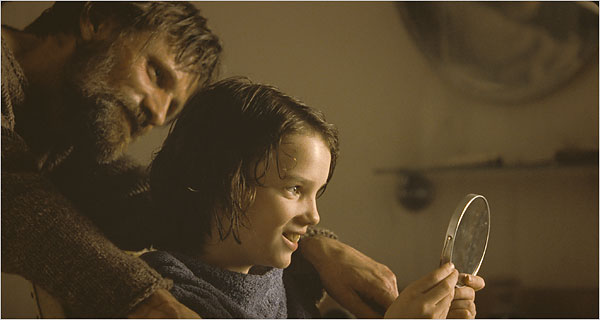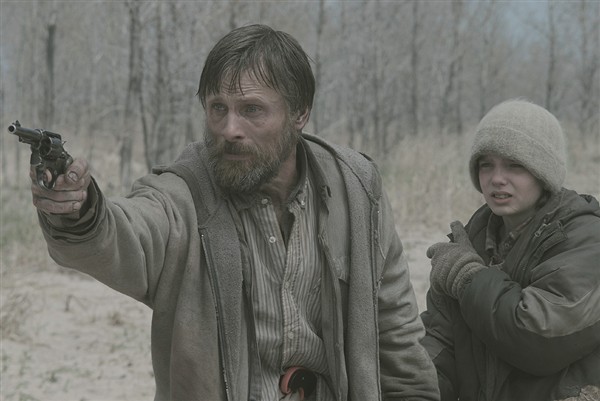This kid needs some milk! Take a journey into the vast exterior emptiness of The Road.
The Road, based on Cormac McCarthy’s Pulitzer Prize winning novel of the same name, was turned into a film in 2009. Directed by Tom Hillcoat, the story follows a man and boy (unnamed in the movie) on the road to the coast, to survival, to a better future. As the movie follows these characters we very quickly understand the movie isn’t just about a bleak future, but rather about trust, love, survival vs. living, and hope. McCarthy first thought of the idea while visiting El Paso, Texas with his son.
The acting in the movie is very strong–entire scenes are carried on the man and boy’s faces, no words needed. Special effects, like the trees falling, seem to be done entirely practically. The visual effects are seamlessly blended in, only used to add broken structures in the background of wide establishing shots. In the editing room, it looks like color compression, correcting, and vignetting were used to add more darkness to the shots in the daytime, and there often is a very slight blue hue to these exterior scenes.  There are barely any shots from the movie that focuses on the destruction solely–there almost always is one of the two main characters placed in every shot. This is important because we get to understand the end of the world solely through these characters’ eyes. There is no showing of destruction or collapse just for the sake of showing it. The cinematography is also used intently and purposefully.
There are barely any shots from the movie that focuses on the destruction solely–there almost always is one of the two main characters placed in every shot. This is important because we get to understand the end of the world solely through these characters’ eyes. There is no showing of destruction or collapse just for the sake of showing it. The cinematography is also used intently and purposefully.
One of the most powerful aspects of The Road is in how it utilizes cinematography to emphasize the emptiness and intimacy of its version of the post-apocalypse. We are often thrust back and forth between two different types of shots, wide shots of the characters set against quiet bleak backgrounds and scenes mere inches away from the actors’ faces. Much of the film is taken up by long still shots of the characters making their way through the wasteland, two small figures surrounded by negative space. These shots help to communicate the isolation the characters feel amidst the post-apocalypse, self-imposed out of fear or by necessity. (Example seen below)
These more bleak scenes are coupled with moments of intense closeness between the father and son, the camera pushing close into their faces, the background often distant and blurred.  This style of shot emphasizes the bond the Boy and The Man share and how they are an (almost) inseparable unit.
This style of shot emphasizes the bond the Boy and The Man share and how they are an (almost) inseparable unit.
The film jumps between these two types of shots, juxtaposing the vast emptiness of a dead world with moments of intimate human connection. This strategy can be seen as an attempt to emphasize the father’s perspective of the world. It is only in these moments of intimacy with his son that the crumbling world of the wasteland seems to fall away, leaving only him and the person he loves most in the world. The negative space in the wide-open shots of them against the landscape accentuating how human bonds can seem so small in a world that has given up on itself.
The cinematography of The Road speaks the same visual language as other post-apocalyptic movies. The muddy, cool-toned, grayscale colors throughout the movie evoke the bleakness of the landscape and of the characters’ inner world. Post-apocalyptic films exaggerate the dullness or lack of color saturation to establish setting or to reflect the character’s feelings. In The Book of Eli, the movie is in sepia because of the pollution in the atmosphere due to war and to foreshadow Eli’s blindness. The Mad Max movies do this to exaggerate the dustiness and heat of the setting. Films that use color to bring focus to the emotions of the characters are I Am Legend and The Last Man on Earth. In I Am Legend there is still a full range of color but it is noticeably duller and warmer tone to evoke the perpetual feeling of dusk and Robert’s yearning for normalcy. The Last Man on Earth, uses the visual language of noir movies, making use of stark contrasts and shadows in the setting that almost act as a character in and of itself.
Like I Am Legend and The Last Man on Earth, the colors in The Road are meant to bring focus to the characters’ emotional complexity. The Road relies on color to examine the theme of hopelessness. The Man is an incredibly complex character that demonstrates this theme well. He does everything he can to nurture and protect his wife (even if she only appears in flashback) and son, yet he doesn’t try to shield his son’s emotional well-being since he teaches him how to commit suicide with a gun and doesn’t bother pulling him away from the three hanged bodies. This part was the most jarring and real since it demonstrates how the post-apocalyptic world alters the mind of an individual. The Road shows that loving people you care for can mean teaching them to expect hopelessness. Protecting the Boy from the truth and teaching him to be unrealistically hopeful and enamored with life is more dangerous and potentially abusive. The idea of altered mindsets is closely connected to the original I Am Legend novel in which Robert resists adapting to the new world of vamps and maintains his humanity, even if it means dying. Furthermore, in The Water Knife, Lucy risks resisting even if it means dying. The Road is almost like the opposite of these two novels because the Man accepts this new world and teaches his son accordingly, yet there are moments where his humanity is still intact.
This altered mindset also affects how the Man perceives humanity. The Man adopts a harsh and survivalist tone by rejecting connections with other stragglers and by attacking thieves.
At the same time, he leaves supplies for the person who stole his precious supplies because he felt sympathy. This connects to a common narrative trope in post-apocalyptic fiction– the hospitable vs. the inhospitable groups. In Sam Sisivath’s novel, The Purge of Babylon, the Sunday brothers are inhospitable, killing outsiders and only taking captives to torture them, while Will and Danny accept strangers in their journey to the bunker. In the novel Emily St. John Mandel’s Station Eleven, the Severn City Airport is the hospitable haven while the cult and various groups in the “archipelago” are armed with guns to prevent thieves and exclude outside.
The Road focuses on the loving, sacred relationship between father and son. The father feels the strong, mandatory responsibility to keep the boy safe and protect him from harm. He believes this is the sort of mission God has given to him – which has a quite similar point with another post-apocalyptic movie ‘The Book of Eli. Eli carries the Bible, listens to God’s word, and considers that as an important mission in a post-apocalyptic world. The two movies illustrate how both protagonists are trying to survive in the post-apocalyptic world within the belief in religion and God. This emphasizes the positive side of religion, which binds people altogether and make them feel safe and relief.
Even though the movie is depicting a quite desperate post-apocalyptic world of the wasteland, it’s also suggesting a new possibility and hope by showing the young boy learning things step by step from his dad. At the same time, it poses a controversial dilemma for audiences: what is the right and wrong thing to do – to teach the young boy – by putting us in the same position with his daddy. Is it the right thing to kill and hurt people to save their own lives? Is it the right thing to consume human flesh, if there’s nothing else to eat? By showing the Man struggling with those problems, this movie makes audiences think about these existential, ethical questions. How do people deal with living now? What is right and wrong, even when there is no law? How does one hold on to hope, or create it? How does small human kindness change an empty world? This is a smart, engaging, and depressing movie, one that follow many of the PA narrative constraints, and yet is an emotional powerhouse.

